Review: Airfix 1/72 Boulton Paul Defiant Mk.I
One of the worst developments in air combat, the concept of a turret‑armed defensive fighter emerged in 1935, when the RAF planned to defend Britain against massed formations of unescorted enemy bombers in air combat that more resembled fleet actions. In theory, turret‑armed fighters would approach an enemy bomber formation from below or from the side and coordinate their fire, as though two battle lines opposed each other. Separating the tasks of flying the aircraft and firing the guns would thus allow the pilot to concentrate on getting the fighter into the best position while the gunner engaged the enemy.
Specification F.9/35, issued that year, requested a two‑seat day and night "turret fighter" capable of 290 mph at 15,000 ft. Boulton Paul had experience with turrets from their Overstrand bomber and submitted the P.82 design. Of the seven proposals tendered, the P.82 was ranked second after Hawker's Hotspur but ahead of Armstrong Whitworth's twin‑engine design. Prototypes of the P.82 and the Hotspur were built. Production orders were prepared for the Hotspur, but the Boulton Paul turret gained the Air Ministry's attention. With Hawker focused on the Hurricane, the P.82 received a production order in 1937 and the Hotspur was canceled in 1938.
The central feature was the four‑gun turret, based on a design by the French aviation company SAMM, which Boulton Paul had licensed for use in the earlier Sidestrand bomber but eventually installed in the "follow‑up" design, the Overstrand, and the Blackburn Roc naval fighter. The turret was an electro‑hydraulically powered "drop‑in" unit with a crank‑operated mechanical backup, equipped with four 0.303 Browning machine guns. The first prototype, K8310, was rolled out in 1937 without its turret. It resembled the Hurricane, though it was 1,500 lb heavier and powered by the same 1,030 hp Merlin I. The newly-named Defiant prototype first flew on 11 August 1937, a year ahead of the Hotspur. A second prototype, K8620 was equipped with a turret. With the turret installed, the Defiant had a top speed of 302 mph. 713 Defiant Mk. I aircraft were built.
264 (Madras Presidency) Squadron was reformed at RAF Sutton Bridge in October 1939 to operate the Defiant. Training and development of tactics began when they received the first Defiants in early December at Martlesham Heath, with night fighter training commencing in February 1940. 264's CO, Squadron Leader Philip Algernon Hunter, flew against Robert Stanford Tuck in a Spitfire, and demonstrated that the Defiant could defend itself by circling and keeping its speed up. By March 1940, 264 had two flights operational, and 141 Squadron received its first Defiant. When the Defiant was publicly introduced, the RAF put out a disinformation campaign that the Defiant had 21 guns: four in the turret, fourteen in the wings and three cannon in the nose.
264 flew their first mission on 12 May 1940, with the Defiants escorted by six Spitfires of 66 Squadron; a Ju 88 was shot down over the Netherlands. The next day the Defiants claimed four Ju 87s, but were then attacked by Bf 109Es. The escorting Spitfires were unable to prevent five of the six Defiants being shot down by frontal attack.
During the evacuation of the B.E.F. from Dunkirk, 264 was based at RAF Manston to cover the evacuation. On 27 May, the Defiants claimed three He-111s destroyed and two damaged. The next day, shortly after takeoff, ten Defiants were attacked by 30 Bf 109s. Forming a circle, they claimed six 109s for the loss of three Defiants.
264 was initially successful because the enemy often mistook the Defiants for Hurricanes and bounced them from the rear. The best day was 29 May 1940, when 264 claimed 37 kills in two sorties: 19 Ju-87 Stukas, most picked off as they came out of their dives; nine Bf-110s; eight Bf-109s, and a Ju‑88. One Defiant gunner was lost when he bailed out, though the pilot brought the aircraft back to Manston.
The Luftwaffe soon changed tactics against the Defiant, with 109 pilots attacking from below or dead ahead, where the turret had no coverage. Defiant losses quickly mounted, particularly among the gunners, who often were unable to get out of their turret. The additional weight of the turret and second crewman combined with the aerodynamic drag meant the Defiant had a lower performance than conventional single‑seat fighter.
The most successful Defiant crew was Flight Sergeants E.R. Thorn, pilot, and F.J. Barker, air gunner, who claimed 13 victories by the end of August 1940, when the Defiant was taken off day operations.
264 developed a defensive maneuver in which the Defiants were flown in an ever‑descending Lufbery circle. This sacrificed the advantage of height but eliminated attack from below, while giving 360 degrees of defensive fire. 264 found success with this tactic, but when 141 Squadron was committed during the Battle of Britain they chose to ignore the advice of 264 - with devastating consequences. On 19 July, seven of nine 141 Squadron Defiants sent to cover a convoy off Folkestone were shot down by Bf-109s of JG 51; the remaining two only survived, one badly damaged, by the intervention of Hurricanes from 111 Squadron. The Hurricanes reported the Defiants had shot down four Bf 109s.
Although 264 Squadron had claimed 48 kills in eight days over Dunkirk, the loss of 14 Defiants (out of 16 in the squadron) was a high price to pay. Actual German losses were 12-15 aircraft, making the victory-loss ratio 1:1; the overclaiming was due to the turret's wide angle of fire allowing several Defiants to engage the same target simultaneously which led to multiple claims.
On 24 August, three Defiants were lost, including Squadron Leader Hunter. On 26 August, as the Defiants engaged 12 Do-17 bombers over north‑eastern Kent, they were attacked by Bf-109Es of JG 3. Three were lost, including two credited to Hauptmann Gunther Lutzow. Six Do-17s and one Bf-109 were shot down in return. Three of these victories were awarded to the top-scoring team of Flight Sergeants Thorn and Barker, who shot down two Do-17s but were then engaged by a Bf-109 which set the Defiant on fire; they managed to shoot down their attacker before making a forced landing. Two days later the squadron lost five Defiants to JG 26, with nine crew members killed. With these losses, the Defiant – which had been intended from the start as a day and night fighter – was transferred to night operations, and there it achieved some success.
THE KIT
Airfix first produced a Defiant in 1/72 scale 50 years ago, and until this past Spring, that was the only kit of this fighter available in 1/72. It had all the deficiencies of kits of that era, with a passing resemblance to the real item, no interior detail, the surface covered by the Airfix Mad Riveter, and decals only provided for a night fighter of 141 Squadron. In 1/48, the Defiant was one of the first kits from Classic Airframes. The less said about that kit the better; several years later Classic Airframes attempted to correct the many errors in the first release with a second release that is no less difficult to assemble, but does make up into a fairly-accurate model. Fortunately, Airfix has announced a week ago that they will release a 1/48 Defiant in February 2016, to go along with their recently released and really quite nice Hurricane I and Spitfire I.
This 1/72 kit by Airfix is based on research done with the sole surviving Defiant, which is displayed at the RAF Museum. The outline shape is accurate, the interior is good for the scale, and the turret is excellent. The one thing that might improve things would be a vacuformed canopy for the pilot's cockpit, but this would then necessitate adding some additional scratchbuilt detail in the cockpit. As it is out of the box, the kit looks excellent with the canopy closed. Decals are provided for two aircraft: a day fighter from 264 Squadron circa July 1940, and a 1941 night fighter from 151 Squadron. The decals include full stenciling and an instrument panel for the pilot's cockpit.
Once again: if you follow the very clear instructions in the very nice instruction booklet Airfix supplies, you will have guaranteed an excellent result.
I painted the cockpit interior details, then assembled the fuselage. I found I needed to do a bit of trimming around the turret position to be able to slip it into position after assembly and allow it to turn. I then assembled the wing, mated that to the fuselage, and attached the oil cooler, radiator and horizontal stabilizers. This all took around two hours to complete. I decided to assemble the model with the fore and aft turret fairings lowered, so the turret could be posed in an active position.
Since I had the really good Xtradecal sheet 72217 for the Defiant, I decided to do the markings for the 264 Defiant as flown during the Dunkirk campaign. At that time, the Defiant was classed a day and night fighter, and had a camouflage of Dark Green/Dark Earth upper surfaces and overall Night lower surfaces. As it turned out from later research, PS-T happens to be the airplane usually flown by Flight Sergeants Thorn and Barker, the top-scoring Defiant team.
The Airfix painting and marking instructions show the camouflage pattern more accurately than does the instructions in the Xtradecal sheet, at least from the photos I found, so I first painted the model RAF Night on the lower surfaces, then Dark Earth and Dark Green on the upper surfaces in the “B” scheme, using Xtracrylix. The nice thing about Xtracrylix is you get a smooth coat airbrushed or brushed, and the same shade. Thus, in 1/72 scale, I could outline the Dark Green areas for the pattern with a 001 brush for the “hard” edge, then fill it in with my airbrush. I hand-painted the pilot's canopy and the turret, with a 00000 brush, on a morning before having any coffee.
I used the kit decals for the stencils and the Xtradecal sheet for the national and unit markings. The model was then given a coat of Xtracrylix flat varnish, the landing gear and prop were attached, the turret was installed and the canopy was glued in position with white glue.
This little Defiant is just as nice as the Do-17, and will look good sitting next to the two “rag wing” Hurricanes I am working on. There's nothing difficult in the project other than painting the canopy and the turret. The Xtradecal sheet provides four day fighter and four night fighter Defiants, one of the day fighters being an air-sea rescue aircraft in the Temperate Sea Scheme and post-1942 national markings. The result is an attractive model of an interesting, if largely unsuccessful, airplane.
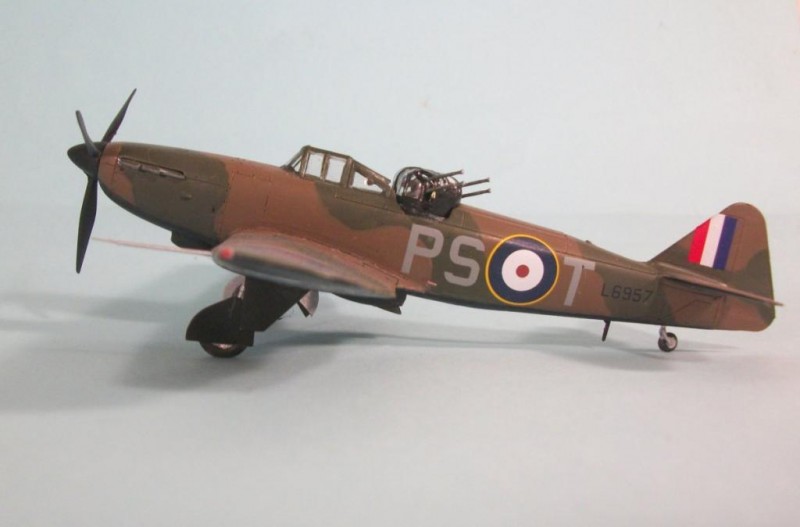
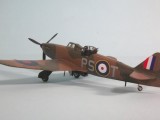


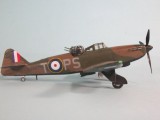
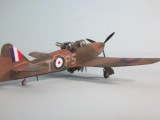
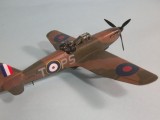
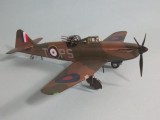
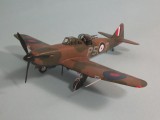

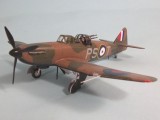
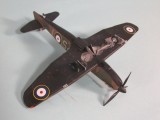
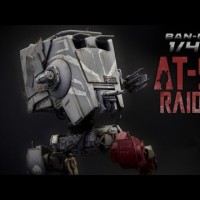
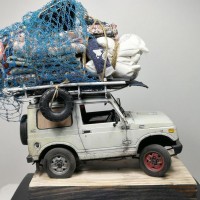
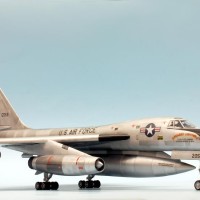
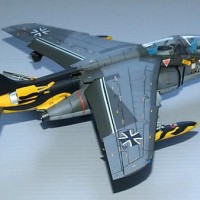
🙂 ... Greetings ... 🙂 :
Very nice Defiant Tom, very nice. Not much of those are seen ( sad fact ), lots of history in those birds.
Very well photographed, thanks for them Tom.
Is the new 1/48 kit an up-scaled version of this kit?
Yes and no, Rob... excellent article about that very issue here:-
http://www.airfix.com/uk-en/news/workbench/5334/
I built the old kit as one of my first builds when I got back into the hobby - this brought back memories...
Nice build!
Great and inspiring build and thank you for the story, that's really exciting, I appreciate when modellers add some history and background here on imodeler.
I'm into Polish squadrons during WW2, so let me only add that the Defiant Mk I was also used in No. 307 Polish Night Fighter Squadron formed in 1940. Actually it was the very first aircraft of the squadron and they claimed a few kills of He 111s, however they were soon exchanged with Beaufighters.
Thanks again, I need to get my hands on this kit.
Tom, lovely job on her.
Best comment I ever heard about the Defiant was by this British model columnist whose name I've forgotten. He said the concept was "Chase me Charlie, and I'll shoot you down".
WW II follow on to the Bristol Fighter idea, that, however, had a forward firing gun.
Holy cow a "Magazine" article being written on a modeling webzine for free...with a great model. The down side my LHS has been slow to get these things. Then again there so popular it would appear that they don't sit on the shelf for long. One has to strike while the iron his hot. Two thumbs up on this one with the hand painted turret and canopy.
Nice build!
P.k
Good to see more 1/72 stuff coming out of the TC stable. Looks very nice indeed Tom, and some useful tips for when I get my hands on this kit.
Nice ! Gotta grab one.
Great build, as usual Tom.
For anyone in North America: Sprue Brothers has the kit for around $7.00, which is cheap! cheap! cheap!
Nice job on an ungainly looking plane.